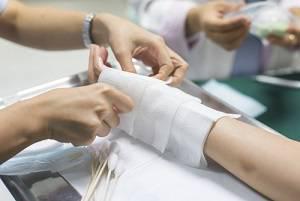Burn Types, Treatments, Potential Complications, and Causes
 Burns are one of the most commonly experienced injuries, particularly among children. Specifically, the American Burn Association estimates that approximately 486,000 burns require medical emergency treatment each year and approximately 40,000 require hospitalization. Thankfully, most instances are survivable and, if treated correctly, many burns have a positive long-term outcome. As such, it is important to know how to treat them, when to seek medical treatment for a burn injury, and what you can expect during treatment and the healing process.
Burns are one of the most commonly experienced injuries, particularly among children. Specifically, the American Burn Association estimates that approximately 486,000 burns require medical emergency treatment each year and approximately 40,000 require hospitalization. Thankfully, most instances are survivable and, if treated correctly, many burns have a positive long-term outcome. As such, it is important to know how to treat them, when to seek medical treatment for a burn injury, and what you can expect during treatment and the healing process.
Most Common Burn Causes
Burns can be caused by any source of heat, including steam, fire, hot liquids, or hot surfaces/items. They may also be caused by chemicals, excessive sun exposure, or electrocution. The most frequent causes in children include hot liquids, hot surfaces/items, sun exposure, and electrocution. It is important to note, however, that they can and sometimes are exposed to other burn causes, including chemicals and fire.
Burn Treatment
The cause can sometimes determine if or when medical treatment should be sought; for example, all electrical burns should be examined by a licensed physician because, even if the skin does not seem to be affected, electrical burns can affect internal organs, tissues, or nerves. But, in most instances, the treatment of a burn is dependent upon the severity of the injury.
Types of Burns
First degree burns, which affect the first layer of the skin, are the least severe and typically only include the outermost layer of the skin. Signs of such a burn include redness, pain, and minor inflammation. In most instances, these can be treated at home with over-the-counter pain medication, antibiotic ointment, loose gauze, and soaking of the wound in cool water for at least five minutes. If, however, there are any signs of infection (pus, a red ring around the wound, etc.), or if the area burned is larger than three inches, or on the face or major joint, the burn should be examined by a doctor.
Second degree burns extend beyond the first layer of skin. Blistering, extreme redness, and extreme pain are signs and symptoms of this type of burn. These can sometimes be treated at home with at least 15 minutes of soaking in cool water, antibiotic cream, and over-the-counter medication. If, however, the burn is larger than three inches, or is on the face, hands, buttocks, feet, or groin area, medical treatment should be sought. If any signs of infection occur, a physician should be seen.
Third degree burns are the most severe and they can affect bones, organs, nerves, tendons, and muscle tissue. These should never be treated at home. Instead, an ambulance should be called immediately. Do not attempt to remove clothing and do not attempt to soak the injury. The individual may not feel any pain because of the extensive damage and they may be in shock. It is important to keep them calm and still until help arrives. Treatment usually includes hospital treatment and a skin graft to repair burnt skin. This type of injury can also lead to death.
Burn Injury Because of Third Party Negligence
While many burns are accidental in nature, there are instances in which burns are caused (or could have been prevented) by a third party. In these instances, the victim may be due compensation. Gimbel, Reilly, Guerin & Brown, LLP can provide skilled and experienced legal representation and ensure the victim’s rights are protected. If you or someone you love needs help seeking damages for a burn injury, contact our Milwaukee burn injury attorneys for a consultation. Call 414-271-1440 today.
Sources:
http://www.healthline.com/health/burns#Overview1
http://www.ameriburn.org/resources_factsheet.php







